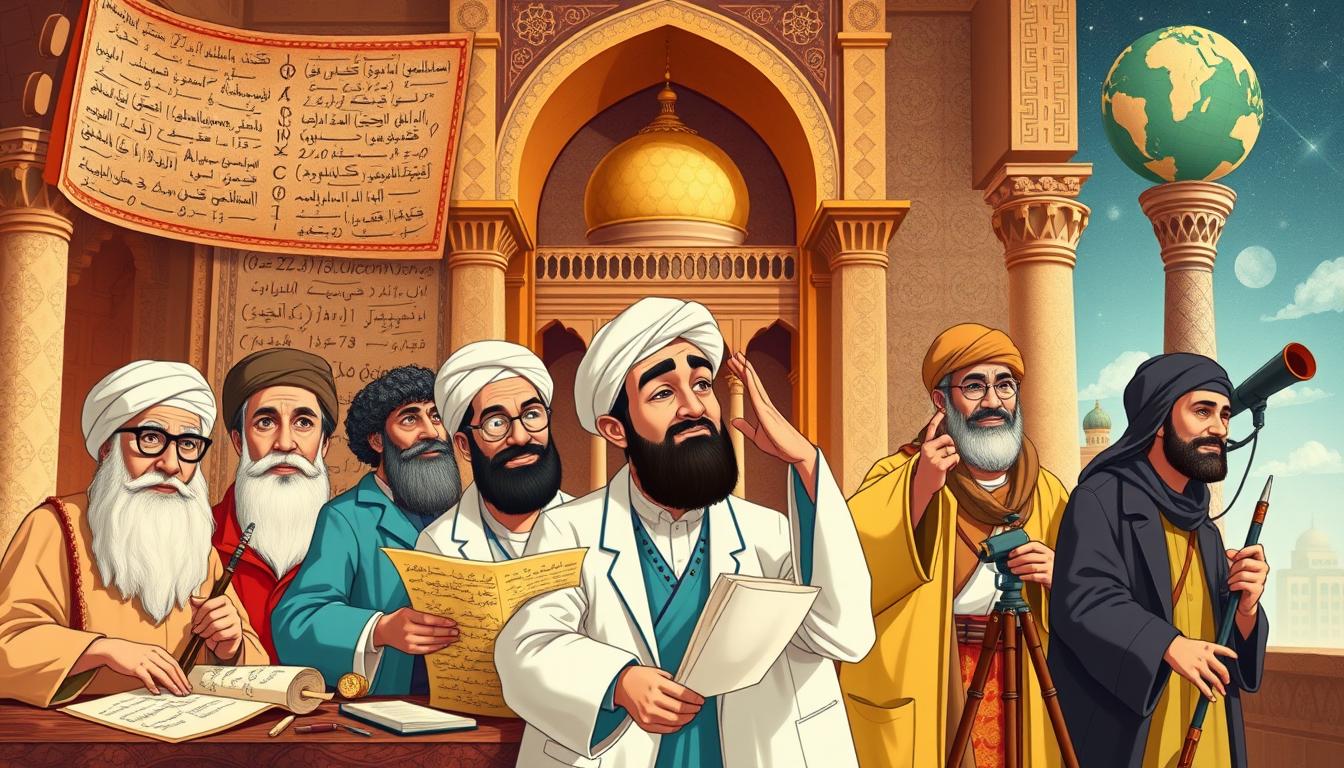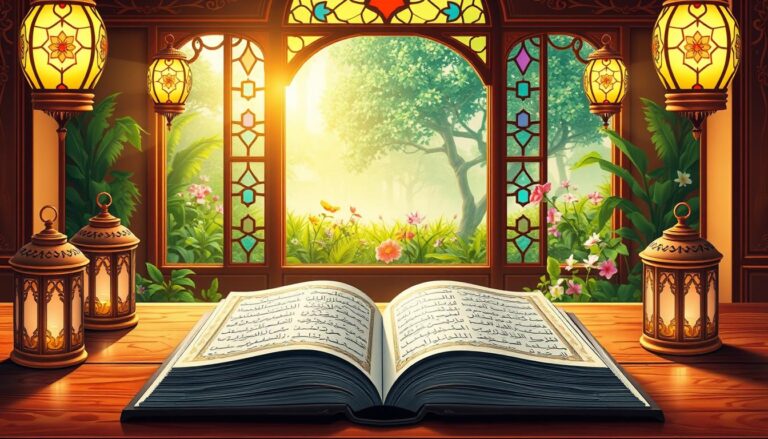10 Muslim Scientists Who Changed the World
Ever wondered about the unsung heroes of science? Muslim scholars have made huge contributions to science and technology. Their work in algebra and optics has shaped our world today.
In the Middle Ages, while Europe was dark, the Islamic world shone bright. Muslim inventors and scholars were way ahead of Europeans. They made big strides in medicine and astronomy.
Their discoveries were inspired by ancient Greeks and Romans. But they took it further, setting the stage for the Renaissance and the Scientific Revolution.
These inventors came from all over, including Arabs, Persians, and Turks. Their work in surgery, physics, chemistry, and geometry still shapes science today. They bridged ancient wisdom with modern innovation.
Key Takeaways
- Muslim scientists made significant contributions during the Middle Ages
- Their work spanned various fields including medicine, astronomy, and mathematics
- Islamic scholars were influenced by ancient Greek and Roman thinkers
- The discoveries of Muslim inventors laid the foundation for modern science
- Their contributions had a lasting impact on global scientific progress
- Muslim scientists came from diverse ethnic backgrounds including Arab, Persian, and Turkish
The Islamic Golden Age: A Brief Overview
The Islamic Golden Age lasted from the 8th to the 14th century. It was a time of great scientific and cultural growth in the Muslim world. During this era, Muslim scientists made huge strides in human knowledge.
Timeline and Significance
From the 8th to the 15th century, Muslim scientists made huge discoveries. Astronomers like Ibrahim al-Fazari and Ulugh Beg helped us understand the universe better. Chemists such as Jābir ibn Hayyān started the basics of modern chemistry and math.
Major Centers of Learning
Baghdad was a key place for learning, with 36 libraries before it was destroyed by the Mongols. Spain had 70 libraries in the 12th century, more than any other part of Europe. These places created a rich environment for learning.
Fields of Scientific Advancement
Muslim scientists were experts in many areas:
- Medicine: Al-Razi wrote 113 textbooks on general medicine, including the 20-volume Continens.
- Ophthalmology: Arab scientists wrote 30 textbooks between 870 and 1370 A.D.
- Physics: Ibn al-Haytham, known as the father of optics, wrote about 90 books, including the influential Almanazir.
- Mathematics: Scholars like Muhammad ibn Mūsā al-Khwārizmī made big steps in algebra and algorithms.
These achievements connected ancient knowledge with modern science. They left a lasting impact on global science.
Muhammad ibn Musa Al-Khwarizmi: Father of Algebra
Muhammad ibn Musa Al-Khwarizmi was a key figure in science. He was born around 780 CE in Persia. His work in mathematics and astronomy changed the game.
His famous book, “Al-Kitab al-mukhtasar fi hisab al-jabr wal-muqabala,” started algebra. Written between 813-833, it introduced new math concepts. The word “algebra” comes from this book’s title.
Al-Khwarizmi also introduced Hindu-Arabic numerals to the West. His book “On the Calculation with Hindu Numerals” made these numbers popular in the Middle East and Europe. This changed how people did math.
“Al-Khwarizmi’s works were the principal mathematical textbooks in European universities until the 16th century.”
As the head of the House of Wisdom in Baghdad from 820, Al-Khwarizmi made big strides. He worked on astronomy, calendars, and even geography. His book “Kitab surat al-ard” helped map the world.
Al-Khwarizmi’s influence is still felt today. The term “algorithm” comes from his name. It shows how his work still shapes science and math.
Ibn Al-Haytham: Pioneer of Optics and Scientific Method
Ibn Al-Haytham was a Muslim innovator who changed optics and the scientific method. He was born around 965 CE. He wrote over 200 works, with many on mathematics and 23 on astronomy.
Contributions to Optics
His most important work, “Kitab al-Manazir” (Book of Optics), changed how we see light and vision. He showed that vision happens in the brain, not the eyes. His work with lenses and mirrors started modern optics.
Experimental Approach to Science
Al-Haytham was a pioneer in scientific testing. He said that theories need experiments or math to be true. This idea came before the Renaissance by centuries.
Influence on Western Scientific Thought
His work greatly influenced Western thinkers. His Book of Optics was translated into Latin and Italian. It inspired scientists like Roger Bacon and Johannes Kepler. His focus on experiments and facts shaped science in the Islamic world and Europe.
“The duty of the man who investigates the writings of scientists, if learning the truth is his goal, is to make himself an enemy of all that he reads, and… attack it from every side.”
Ibn Al-Haytham’s legacy inspires scientists today. His work connected ancient and modern science. He left a lasting impact on global science.
Avicenna (Ibn Sina): The Polymath Physician
Avicenna was born in 980 near Bukhara, Iran. He was a key figure in medicine and philosophy. He wrote about 450 works, with 240 still alive today.
Avicenna was a genius in many areas. He wrote about mathematics, astronomy, physics, and poetry. His famous “Canon of Medicine” was a key text in Europe for centuries.
His work had a huge impact on medicine worldwide. Gerard of Cremona translated “The Canon” into Latin in the 12th century. It was a top text in European universities until 1650.
“If you want to understand medicine, you need to understand Avicenna.”
Avicenna made big strides in medicine. He linked sweet-tasting urine to diabetes and described anthrax. He used wine to treat wounds and fixed bone deformities.
- Authored 450 works across various fields
- “The Canon of Medicine” divided into five comprehensive books
- Introduced systematic experimentation in medicine
- Described 760 drugs in his medical encyclopedia
Avicenna’s legacy inspires us still. His work is the base of modern medicine. It shows the talent of Muslim inventors in the Islamic Golden Age.
Al-Biruni: Master of Astronomy and Geography
Al-Biruni was born in 973 CE and became a key figure in science. He made big contributions in astronomy, geography, and math. During the Islamic Golden Age, he wrote 146 books, with 95 on astronomy and related topics.
Astronomical Discoveries
Al-Biruni’s work in astronomy was groundbreaking. In his major book, Mas’ud Canon, he showed that the Sun’s apogee moves, unlike Ptolemy’s fixed theory. He also created methods for observing the sky and found the Earth’s radius with great precision.
Contributions to Geography and Cartography
Al-Biruni’s studies in geography were also significant. He believed the Earth is a globe with a varied surface. His method for measuring the Earth’s radius was only 2% off from today’s values.
Mathematical and Physical Sciences
Al-Biruni was also a master in other sciences. He studied physics, natural sciences, and even geological eras. His work on Indian astronomy included insights on Earth’s rotation and a critique of astrology.
“The difference between truth and falsehood is as clear as that between day and night.”
Al-Biruni’s vast knowledge and scientific methods still impact many fields. He is remembered as one of the most influential Muslim scientists in history.
Jabir Ibn Hayyan: The Alchemist Who Shaped Chemistry
Jabir Ibn Hayyan was a key figure in Islamic science, especially in chemistry. Known as Geber in Latin, he lived in the 8th century. His work greatly influenced chemistry, shaping it for centuries.
Jabir made many important contributions to chemistry. He developed key processes like:
- Distillation
- Crystallization
- Filtration
- Sublimation
- Evaporation
These methods changed how scientists studied substances. Jabir focused on experimentation and organizing chemical knowledge. He wrote about 215 treatises, covering alchemy and more.
Jabir’s work didn’t just stay in the Islamic world. In the 13th century, his books were translated into Latin. This spread his ideas to Europe, helping science grow worldwide.
“Muslim chemists introduced the concept of experimentation and laboratory practices, emphasizing practical work.”
Jabir’s influence is still seen in chemistry today. He helped classify chemicals and showed how to make inorganic compounds from organic ones. His work turned alchemy into a science.
Impact of Muslim Scientists on Global Scientific Progress
Muslim scholars in the Islamic Golden Age changed science forever. Their work in many fields set the stage for today’s science.
Impact on Global Scientific Progress
While Europe was in the Dark Ages, Muslim scientists were making big strides. In places like Baghdad and Cairo, they advanced algebra, chemistry, medicine, and astronomy. The 1001 Inventions exhibition at London’s Science Museum highlights these forgotten achievements.
Legacy in Modern Science
Arab math and science have left a mark on Western science. Many English words, like algebra and algorithm, come from Arabic. Ibn al-Haytham’s work on optics still guides modern theory. Al-Zahrawi’s inventions, like the syringe and bone saw, are still used today.
Bridging Ancient and Modern Knowledge
Muslim scholars kept and expanded on ancient Greek and Roman knowledge. They built observatories and developed tools for astronomy. By the 13th century, their medical knowledge started to influence Europe. This helped link ancient wisdom to modern science.
- Al-Mamun built the first observatory in Baghdad
- Islamic astronomers created tools like the astrolabe
- Al-Razi compiled the Comprehensive Book of Medicine
The Islamic scientific community, with Muslims, Christians, and Jews, was diverse and rich. Their work during the Golden Age of Islamic science still shapes our world.
Omar Khayyam: Mathematician, Astronomer, and Poet
Omar Khayyam was born in 1048 in Neyshābūr, Khorāsān. He was a remarkable figure among pioneering Muslim mathematicians. His talents spanned mathematics, astronomy, and poetry, leaving a lasting impact on these fields.
Khayyam was a key figure in astronomy. He worked on calendar reform. At the Observatory in Esfahan, he and his team measured the year’s length with great accuracy: 365.24219858156 days.
This precision led to the creation of the Jalālī calendar. It was introduced in 1075 by Sultan Malik-Shāh.
Khayyam’s work in mathematics was impressive. He wrote a treatise on algebra and geometry. His work, Risālah fiʾl-barāhīn ʿalā masāʾil al-jabr waʾl-muqābalah, advanced algebraic understanding.
He also critiqued Euclid’s theories on parallels and proportion. This laid the groundwork for future developments in non-Euclidean geometry.
“Be happy for this moment. This moment is your life.”
Beyond his scientific achievements, Khayyam was known for his poetry. His quatrains, known as robāʿīyāt, were translated into many languages. This shaped Western views of Persian poetry.
The 1859 translation by FitzGerald, The Rubáiyát of Omar Khayyám, became very popular. It influenced Western literature.
Omar Khayyam’s legacy as a pioneering Muslim mathematician and influential Muslim astronomer continues to inspire. This is nearly a millennium after his passing in 1131.
Al-Zahrawi: The Father of Modern Surgery
Al-Zahrawi was a Muslim scientist who changed surgery forever. He was born in 936 AD in Cordoba, Spain. This was during the Islamic Golden Age, a time of great scientific progress.
His 30-volume medical encyclopedia, “Al-Tasreef,” was key for centuries. It became a major source of surgical knowledge.
Surgical Innovations
Al-Zahrawi’s work in surgery was groundbreaking. He created over 200 surgical tools, many of which he designed himself. These tools, like scalpels and scissors, are still used today.
He also performed the first thyroidectomy. He found new ways to treat hydrocephalus and spine injuries.
Medical Instruments and Techniques
Al-Zahrawi did more than just make tools. He wrote about new surgical procedures like tonsillectomy and tracheostomy. His work covered many areas of medicine, including pediatric surgery and pharmacology.
He stressed the need for basic sciences in medicine. This was a forward-thinking idea for his time.
Influence on European Medicine
Al-Zahrawi’s work had a huge impact on science worldwide. His book “Al-Tasreef” was translated into Latin in 1150 AD. It was used in European medical schools for over 500 years.
The famous French surgeon Guy de Chauliac called it “the greatest achievement of medieval surgery.” Al-Zahrawi’s work helped connect ancient and modern medicine, shaping surgery’s future.
Source Links
- 15 Famous Muslim (Arab & Persian) Scientists and their Inventions
- The Muslim scientists who changed the world
- List of scientists in medieval Islamic world
- Arab and Muslim scientists and their contributions to the history of ophthalmology
- Al-Khwarizmi | Biography & Facts | Britannica
- Al-Khwarizmi
- Ibn Al-Haytham: Father of Modern Optics
- Ibn al-Haytham
- Ibn al-Haytham’s scientific method
- Ibn Sina (Avicenna): The Prince Of Physicians
- Avicenna | Biography, Books, & Facts | Britannica
- Avicenna
- Al-Biruni
- The Science of Al-Biruni – Muslim Heritage
- Jabir ibn Hayyan
- From Alchemy to Chemistry – Muslim Heritage
- The greatest scientific advances from the Muslim world
- Omar Khayyam | Persian Poet, Astronomer & Mathematician | Britannica
- Omar Khayyam – Biography
- Omar Khayyam
- Abu Al Qasim Al Zahrawi (Albucasis): Pioneer of Modern Surgery
- Microsoft Word – A Elgohary. Al ZahrawiThe Father of Modern Surgery.doc
- How a 10th-century Muslim surgeon revolutionised surgical procedures







